#lumberwood
Photo
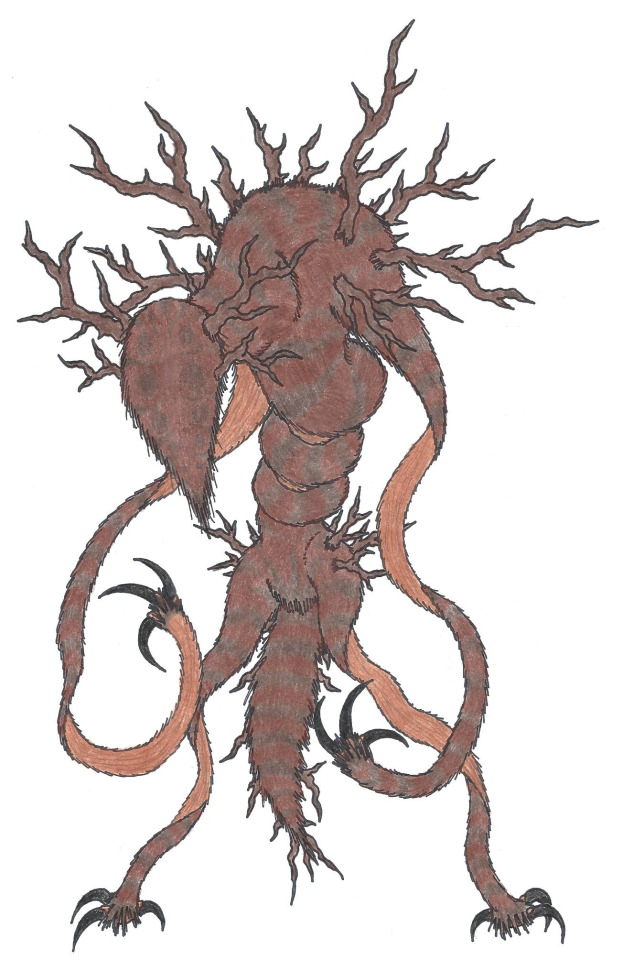
Of all the beasts affected by man's progression and development of the land, it should be obvious that the fate of the Hidebehind was one we did not see. As a species famous for hiding from sight, even under impossible circumstances, how could we know what befell them as urbanization and fragmentation consumed the continent? We knew they existed, the olden tales made sure of that, but in what numbers and what health, we simply didn't know. As the trees turned to steel and the earth to asphalt, we wondered what became of them with many of their homes lost. Did they flee to wilder lands, hiding in parks and preserves? Did they perish as the trees they hid behind toppled down atop of them? It was hard to say. Obviously, a population count was impossible. You can't see what is determined to remain hidden. The successes in trapping them didn't help much either, as tagging them and tracking them simply didn't work. Any marks given to them vanished, and all equipment strapped or injected simply fell off. The dilemma always brought to mind the old tale of a man who caught a Hidebehind, and was determined to see its true form. The man took shears to its shaggy coat and shaved it down until he was somehow left with only a pile of fur, claws and branching horns. Perhaps we could not tag them because there was nothing to tag, a body so impossibly thin and fluid that it defied all known methods. Glimpses and sightings did give us an idea of their locations, and trail cams helped pinpoint a few roaming groups. All this, though, was a drop in the bucket compared to what we didn't know. Were these individuals just the few of the many we were able to see, or are they the last of their kind? A vanishing species now vanishing for good?
If there is one good thing to come from the increase in security systems and public monitoring, it is the fact that cameras in cities started to reveal the fate of the Hidebehinds. As we consumed their home forests, we assumed they fled to greener pastures. It seems now, though, that these phantoms clung to our own shadows and stood as witnesses as we constructed our own nests. Security cameras and paranoid neighborhoods would claim to see movements in shadows, or suspect some foul miscreant lurking in the night. At the time, most of these incidents were chalked up as people seeing criminals and hoodlums in every dark alley or poorly lit street. The media filled parents and homeowners with fear of the faceless stranger, of the unseen roaming gangs of thieves and murderers waiting patiently for an unlocked door or unsecured window. So when countless sightings and reports came in, no one thought much of it. Just another case of paranoia or overreaction to a new neighbor who didn't quite fit the suburban standard. After a few undeniable videos caught on security cameras, researchers scrambled to collect all these odd reports and comb through them. It then became clear that the Hidebehind had been amongst us this whole time, lurking in the alleys, street corners and backyards. Though their trees were gone, there were still plenty of places to hide, and they did so with the same masterful technique as always. Food was no worry for them, as they just followed the ways of the raccoon, crow and other urban pests. Trash cans and dumpsters were rummaged, unattended food items were swiped, and the victims of the ceaseless road gave them access to plenty of meat and intestines. It should have been obvious at that point, when people complimented road crews for their impeccable work of cleaning up roadkill. Somehow those messy carcasses disappeared overnight, yet no one gave thought on the fact no one saw a single truck come by to do it.
As more footage has been compiled and strategic cameras have been placed, we have learned more of the Hidebehind's adaptations. They use the shadows made from streetlights to slink about. They have figured out motion sensors and know how to slip past these automatic lights, or how to use them as a distraction. Fences are godsends and attics are safe havens. They have learned of the stray animals that wander the streets, and the pets that foolish owners let roam free. It turns out coyotes aren't the only ones to blame when Mittens doesn't come home in the morning. Doggie doors let in more than just Fido, and every cracked open window has a chance of inviting someone else to your home. Researchers also claim that their adaptations aren't just behavioral, but physical as well. Pictures have shown that their furs have grown darker and blacker in color, to further cloak themselves in the shadows. It also appears that their branching horns are becoming shorter and less prominent, as they have fewer trees to blend in with. It seems like the Hidebehinds are doing just fine, moving right in with us and taking advantage of this new ecosystem we've created. Most people are less thrilled about this, but there is little they can do. How can you call an exterminator for something you can't even see?
Despite all that was learned, there was one question that still plagued the research community. We saw how the Hidebehinds hunted and traveled in our towns and cities, but what of their young? Where did they keep their pups as they lurked in the shadows of our civilization? Young Hidebehinds were once kept in the hollows of trees or in caves, waiting for mommy to come home with fresh entrails. Though they are pretty good at hiding at a young age, they are a bit clumsy, sloppy and a tad rambunctious. Even when mom says to sit still and wait, they tend to wander sometimes and get caught in some play. In the tranquil forest, this was no harm, as no beast could catch a Hidebehind pup, let alone even spot one. But in our jungles of concrete and steel, not every danger has eyes to see. Speeding cars, roaring construction equipment and the flowing sea of humanity provide plenty of threat to bumbling pups. No doubt they would be trampled or run down, even if the foe didn't see them in the first place. However, no such reports have come in, so the Hidebehinds must have found a safe haven for their young. Many assumed that the city provided plenty of crevices and holes for them to make nest, like dumpsters or abandoned buildings. Some suggested they moved to city parks and playgrounds, using the trees found there. Others believed they left the city and took their young to the outskirts, despite the grueling journey that would be for the tending mother. The theories were many, but none properly answered the question. Even so, no footage or pictures were coming out to prove any of them true. In such a surveillance state, surely a Hidebehind nest in a park or empty building would eventually be captured, right? But none were ever revealed, which left us all not knowing. Well, not exactly all of us.
Though there was plenty of arguing and debate over the mystery of Hidebehind pups, there was one group who knew the answer quite well. Their claim was made quite early on, but no one paid them any mind. The answer was right there in front of everyone, but no one bothered to think twice on it. Throughout all this, this one group continued to champion their solution to this mystery, but we ignored them again and again. It was only until recently when a research team decided to test this preposterous theory and then shockingly find it to be true. One would say "who would have guessed," but there were plenty of folk who had already guessed long before this. It seems obvious now, but no one could have really imagined the Hidebehinds to be this crafty. After all, what beast would be so bold to place their young in such a location? What creature rears its pups in the nest of the ecosystem's apex?
The revelation of this fact has set the research community, and many households, ablaze with questions, worries and concerns. How did this happen? When did this happen? How come it took us so long to figure it out? These were the storm of demands that came from so many homes and parents. They make accusations now, of the scientists being stupid and oblivious, but before all this they were just as ignorant to the truth. They didn't listen at all when the theory was championed again and again. After all, what parent truly believes their child when they say there is a monster in the closet?
--------------------------------------------------------------------------
“Hidebehind”
"Wait a second, didn't you already draw a Hid-" INDEEDY DO! Yes, I have already drawn a Hidebehind and given it my usual ludicrous spin, but that was before I started doing this modern fearsome critter thing and the entry had nothing really to it. "So why not redraw the old des-" REDRAW?! IN THIS HOUSEHOLD!? Make the same thing twice you say?! Ludicrous! Preposterous! Unthinkable! To reuse a design, the gall! It has nothing to do with the fact that I struggle to draw the same thing twice, it is a matter of......uh.....ethics! Doing the same design again would mean I would have to give it a different pose, or show it from a different angle, or literally draw it in a way that I can't draw it! And we can't be having that here! So here is a new Hidebehind design with lore to match! I had to make this entry after I stumbled upon the revelation that boogiemen are just urbanized Hidebehinds.
39 notes
·
View notes
Text




Allsfor Tech, agora disponível no material Lumber Wood!😍
Allsfor Tech, now available in Lumber Wood material! 😍
|+ info --> [email protected]
|www.allsfor.com
#allsfor#porcelain#allsfortech#lumberwood#technology#technologylovers#creativity#sustainable#interiordesign#inspiration#designstove#slabs#surfaces#designinspiration#kitchendesign#induction#homedesign#designinterior#countertop#worktop#architecture#decor#decoration#cozinha#home#home & lifestyle
2 notes
·
View notes
Text
https://todiantimbers.com
1 note
·
View note
Text
#fearsome critters#fearsome critters of the lumberwoods#cryptids#folklore#monsters#urban legends#polls#jackalope#squonk#fur-bearing trout#hodag#teakettler#sidehill gouger#hoop snake#slide-rock bolter#axehandle hound#axhandle hound#hidebehind
14 notes
·
View notes
Text
d20 neverafter original characters are OUT original worlds are IN
#i want to see peoples world ideas#mine would be called the Lumberwoods and be based on the fearsome critters from north american lumberjack folklore#d20#dimension 20#dimension 20 neverafter#neverafter
7 notes
·
View notes
Text
i need to be obsessed about fearsome critters and cryptids so bad
#i already am actually i just. i love lumberwoods critters. its great#do I particularly believe in cryptids? no.#do i think theyre sooo cool and cute?#hell yeah#thoughts
4 notes
·
View notes
Text
very good mail day. the only one of these I recognize is the squonk, this is gonna be fun


3 notes
·
View notes
Text

77th Book I Read in 2023
Title: Fearsome Creatures of the Lumberwoods
Author: William Thomas Cox
Notes: Loved, loved, loved this book and the weird creatures in it! Definitely going to be keeping this one in my shelf.
#Fearsome Creatures of the Lumberwoods#William Thomas Cox#fiction#nonfiction#book#books#bookblr#reading#2023#english#engelska
0 notes
Text

Hunters who are good at tracking are able to follow a squonk by its tear-stained trail, for the animal weeps constantly. When cornered and escape seems impossible, or when surprised and frightened, it may even dissolve itself in tears.
— William T. Cox, "The Squonk", Fearsome Creatures of the Lumberwoods (1910)[1]
#digital art#animated gif#squonk#cryptid#crying sad lil guy T^T#this is a gift 4 my sister and her friend they love cryptids :3#i just think they're neat#apparently there is an event called Squonkapalooza that happened this month lol#so this works well for the monthly gif#we actually went to a different cryptid event this year it was fun
95 notes
·
View notes
Text
So you know which cryptid is at the top of my personal list for “most delightfully ridiculous cryptid?” The Slide-rock Bolter. It’s a lesser known cryptid that seems to have originated from miner/trapper folklore in 19th century Colorado, and…it’s a land whale.
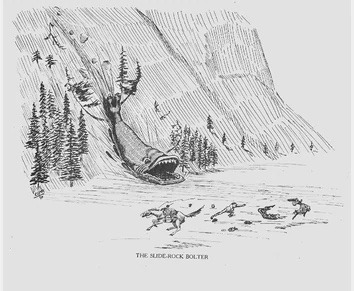
It hooks onto the peak of a mountain with its tail and when it sees something it wants to eat, it lets go and zooms down the slope, swallowing everything in its path whole.
It is not clear how it gets back up a mountain once it’s done this, but I suspect it can manage.
EDIT: Thankfully, someone in the notes found the source of the image—it should be in Fearsome Creatures of the Lumberwoods here: https://href.li/?http://www.lib.lumberwoods.org/
#slide-rock bolter#cryptids#listen this one is so silly I wish it were real#Bigfoot is boring give me the drop whales
211 notes
·
View notes
Text
A Hundred Some New ATOM Kaiju Pt. 8
In this installment of the unfinished ATOM kaiju showcase, we're looking at the monsters for one specific ATOM story: "Paul Bunyan Was A Kaiju?"
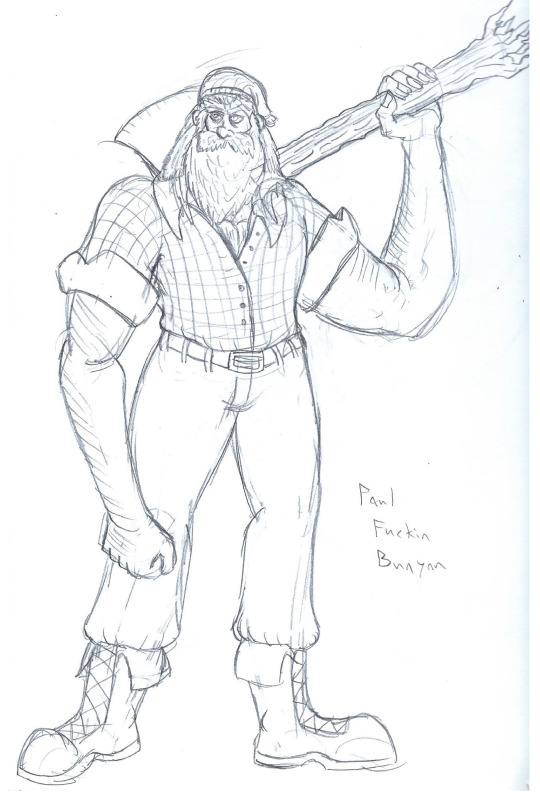
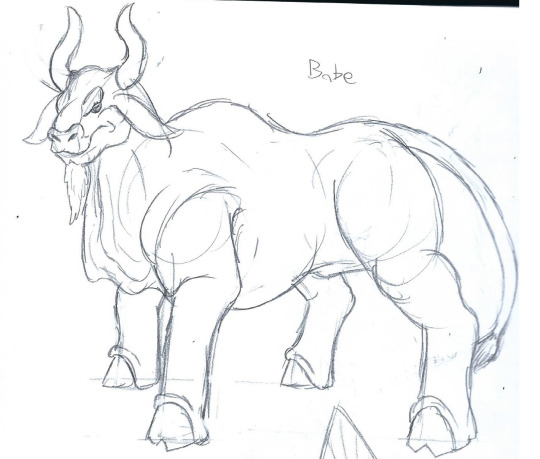
So, like, the plot of this story would involve Dr. Lerna and another kaijuologist exploring the wilderness of Michigan's Upper Peninsula, with the later explaining to Dr. Lerna how Paul Bunyan was not only real, but a kaiju, and have Dr. Lerna play the part of Dana Sculley for a change. It would be kept ambiguous for most of the story whether or not the story is true or just an atomic spin on a tall tale.
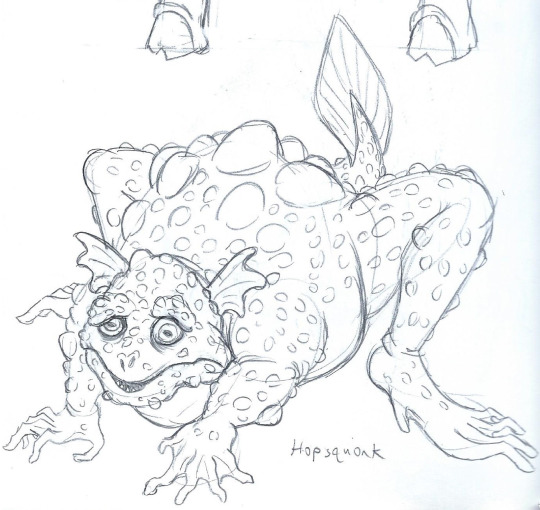
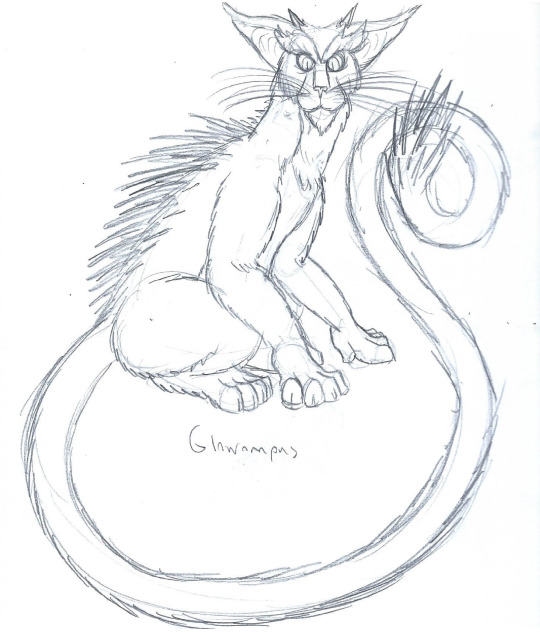
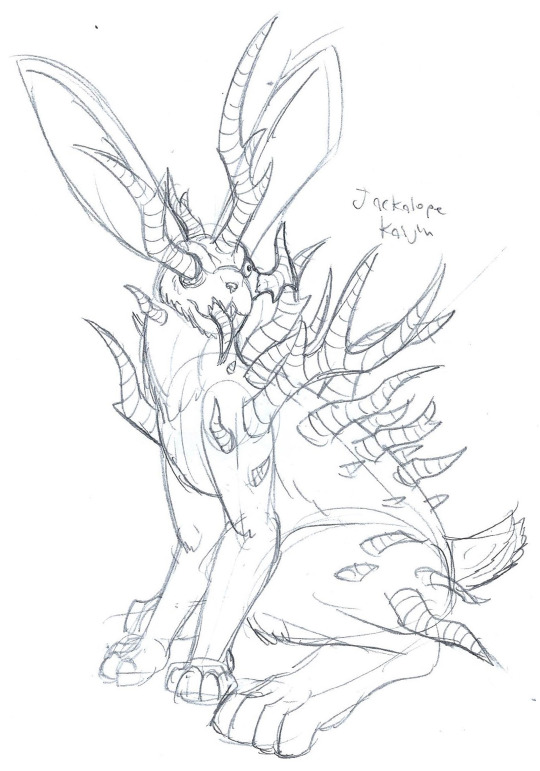
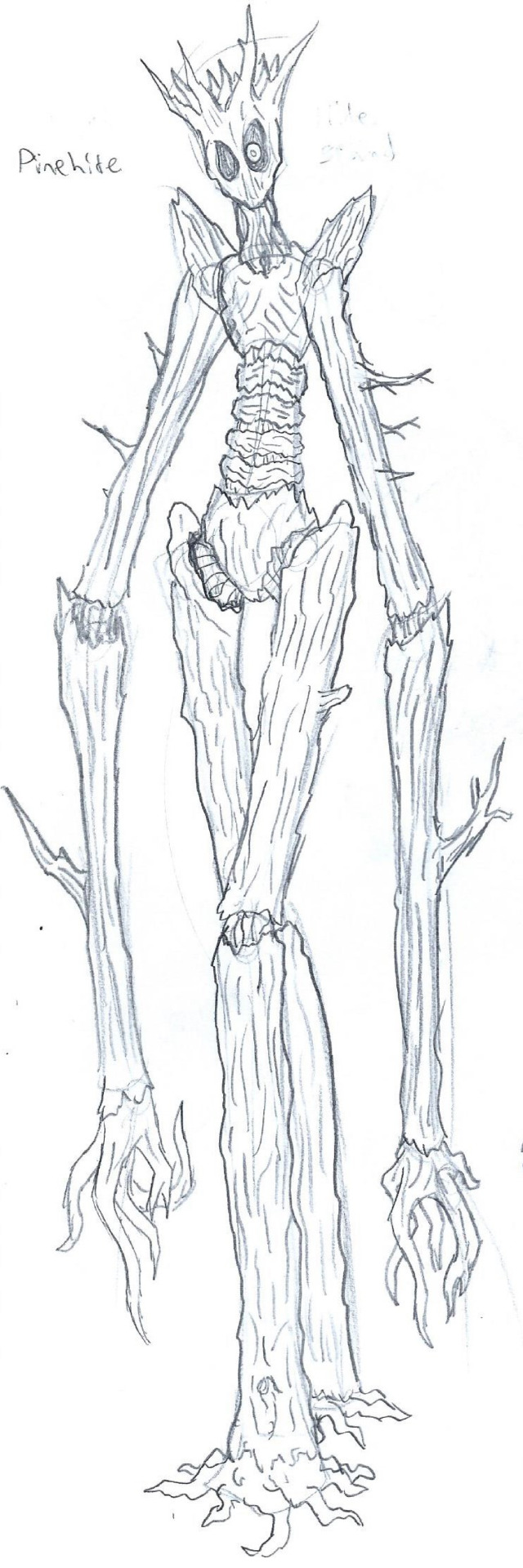
The story would feature kaiju inspired by Fearsome Critters of the Lumberwoods: a frog-like Squonk, a feline that mixes the Tailypo/Wampus Cat and the Cactus Cat, a really fucked up Jackalope, and an utterly enormous Hide Behind.

The final boss of the set, and the monster that supposedly fatally wounded Paul Bunyan, would be a nasty carnivorous deer kaiju named Baerwok, being loosely based on the Bear Walk from Escanaba in Da Moonlight, which in turn was loosely based monsters made up by white American settlers' flawed understanding of Native American legends. Paul Bunyan dies slaying an Algernon Blackwood monster, basically.
Or... does he? Is Paul Bunyan truly dead? Or does he even exist at all? You'd have to read the story to find out, which means I have to write it one of these days.
22 notes
·
View notes
Text
Fearsome critters are joke animals that were made up by lumberjacks in the United States.
I have been researching fearsome critters for some time and as far as I am aware, the best place for this is the Lumberwoods website, which hosts many old books on them.
When I read about a critter, I look it up to see if there is anything else I can find, but many named critters do not have anything outside of these books.
So, I was reading Lenwood’s Lexicon of Lumberwoods Lore, where I came upon "Swamp Boogers." Which is said to be the taxidermy of deer buttocks being turned into a face.
What's weird is that it does not seem to be alive in any way, as you would expect from a fearsome critter. It is just taxidermy.
And it is a real thing that has been done to animals and you can read about it on Know Your Meme.
But when talking about the origin of swamp boogers, Know Your Meme says, "The term "Swamp Booger" has likely been used prior to its appearance online," and it lists a song from 2004 that uses the term.
But the book I read is from 1951.
I found some information and put it together to give us more context to something almost no one cares about.
You're welcome!
13 notes
·
View notes
Text
Cryptid Collection Spotlight: The Squonk
We're going to be spending this week infodumping about the six cryptids we chose to feature in our Cryptid Collection! We'll be posting about the lore and origins, our thoughts, experiences, and relationships with all of these cryptids, and we encourage folks to share their own!
Today we're talking about the most #relatable cryptid, the Squonk.

👣The Cryptid Collection
🗺️Cryptid Travel Posters
👥Cryptid Binders & Sportsbras
🧵Cryptid fabric designs
Much like the Jackalope that we spotlighted yesterday, the Squonk is a creature from tall tales of the previous centuries.
Descriptions of the Squonk nearly all originate from the same source. Fearsome Creatures of the Lumberwoods was a 1910 collaboration between William Thomas Cox, Minnesota's first State Forester and Commissioner of conservation, who wrote the text; Coert du Bois, US Consul and forester, who drew the illustrations; and George Bishop Sudworth, Chief Dendrologist of the Forest Service, who created the Latin classifications. In the introduction, Cox claims that the fantastical field guide was born out of a desire to preserve some of the tall tales invented by lumberjacks and the stories they told about them around campfires "to regale newcomers and frighten people unfamiliar with the woods". The guide details twenty creatures from heavily wooded regions all over the US. There on page 31, between the Hodag of Wisconsin and Minnesota, and the Whirling Whimpus of Tennessee, lies our friend, the Squonk.
Later texts inspired by Fearsome Creatures expanded on the lore, describing, among other things, a mass migration from its original widespread territory that resulted in the evolution of webbed toes, but only on its left feet; wax and hair-covered ears; crooked yellow tusks; and asexual reproduction through cell division. But Cox's original, much more straightforward description, seems to have truly stood the test of time.
The Squonk, like many regional cryptids, has a fairly small territory, being limited to the hemlock forests of northern Pennsylvania. Cox claims that those familiar with the Squonk describe it as being "the most morbid of beasts". These days, we might interpret that to mean a fearsome creature that lurks in the darkest, thickest part of the woods, hunting unsuspecting lumberjacks who unknowingly wander into its territory and toying with them the way a cat toys with a mouse. Quite the contrary, though, the Squonk is described as morbid because of its constant weeping, the source of which is the skin which hangs off of it in wrinkles as if it were a piece of much too large clothing, and its many warts and moles.
While the Squonk is most active during the twilight and dusk hours, it can also be found traveling at night. In fact, Cox relates that "frosty moonlight nights" are the best conditions for Squonk hunters, as it doesn't like to move much at all on those nights, and its tears flow more slowly. Why might slowly flowing tears be an advantage, especially when the trail those tears leave behind in the Squonk's wake are an easy way for hunters to track it? Why, because the more scared the Squonk is, the more tears it cries, and likely it is to be completely dissolved by those tears.
In fact, this curious characteristic is described in the only encounter related by Cox:
Mr. J. P. Wentling, formerly of Pennsylvania, but now at St. Anthony Park, Minnesota, had a disappointing experience with a Squonk near Mont Alto. He made a clever capture by mimicking the Squonk and inducing it to hop into a sack, in which he was carrying it home, when suddenly the burden lightened and the weeping ceased. Wentling unslung the sack and looked in. There was nothing by tears and bubbles.
It's probably fairly obvious why an inherently queer company selling garments intended to relieve body dysphoria would relate to a creature like the Squonk, which is so uncomfortable in its own skin that it simply can't stop crying. But we're certainly not the first to feel empathy and kinship with the Squonk. In fact 2024 marks the second annual Squonkapalooza in Johnstown, PA, hoping to "turn those frowns upside down. Spreading the love of the Squonk might cheer them up."
Which is fair! I think that if most of us discovered a festival organized and attended out of pure love and empathy for us we'd probably feel a little bit better about ourselves.
11 notes
·
View notes
Note
Top five silliest cryptids go
1. every fearsome critter of the lumberwoods is peak silly, so i’m just picking the silliest: the hugag!
2. gef the talking mongoose
3. bigfoot, but the mormon version where he’s actually cain
4. the tatzelwurm (because the only way a normal cat can be sillier is if it had a snake body)
5. fur-bearing trout (sorry one more fearsome critter, i couldn’t resist)
51 notes
·
View notes
Note
hihihi pidge!!
🥤🔪🦴 for the ask game :0
hi davey!!!
🥤 ⇢ recommend an author or fanfic you love
smoke and stone giants by @just-pot-over-here! to be clear this is more of,,, i'd say a demo of a fic, since the author is currently taking a break from it to work on their own writing skills (writer break buddies unite) but even so, this hiatus'ed fic with only chapter out understands crutchie, race and their dynamic together so much better than anyone in this fandom, to the point where i'd say it's worth reading even if you're not a crutchtrack truther. they understand the rage these two characters have, the ways in which they mask it, and the ways in which this unites the two, and it's incredible to see written out in words. MWAH. chefs kiss. gorgeous fic. cannot wait to see where it goes and to see the other crutchtrack content this author puts out when they feel ready to :)
🔪 ⇢ what's the weirdest topic you researched for a writing project?
i have read 'fearsome critters of the lumberwood' so many times that it's the automatic search option when i type the letter 'f' into my search bar. don't write fics about cryptids.
🦴 ⇢ is there a piece of media that inspires your writing?
yknow now that i think about it i feel like a lot of the imagery and voice i try to implement in my writing comes from a lot of cartoon saloon's work, specifically wolf-walkers. those funky cartoonists understand emotion through imagery better than anyone in the world. 10/10 would recommend.
7 notes
·
View notes
Photo

From So You Want To Be A Wizard: Perytons.
(And a bit of discussion from an older Tumblr post:)
When I first started reading the Young Wizards series, I read and took on the Perytons introduced in So You Want to Be a Wizard as they were but recently started coming across other mythological Perytons — crosses between stags and birds — and so was thrown off on some of my mythology. Since they share names, I'm curious where you got the idea for the Perytons shown in SYWtBaW.
I borrowed it from Jorge Luis Borges, as everyone else has (whether they know it or not. Many, if not most, seem not to). ...And then tinkered with the concept to suit myself: just as Borges had.
Some background under the cut...
Borges’ The Book of Imaginary Beings was published in the late 1960s, initially in Spanish in 1967 and then in an English translation in 1969 (my copy is the Discus/Avon paperback published that year). It is a compendium/collection of more than a hundred of Borges’ short fictional works—many written for The New Yorker, and the rest either written specifically for this collection or published elsewhere without those previous publications being cited in the book.

Now, though a lot of people have taken the title of this book at its face value, assuming that it’s a reference to earlier mythological or fantastic creatures, it’s frequently not. Many of the creatures in it show signs of being Borges’s inventions, despite being attributed to other sources, and to my eye the peryton is the most obvious of these.
It doesn’t hurt to remember that Borges as a writer is (when the mood moves him) not merely playful but often hilariously subversive, if not downright mischievous. In TBIB he’s very careful with his cites when he needs to be—his entries on “An Animal Imagined By Kafka”, “An Animal Imagined by C. S. Lewis”, “A Crossbreed”, and “The Odradek”, all carefully cite their sources and permissions in the front matter. Some other works that were apparently out of copyright he identifies without citation in the front matter (such as the wonderfully titled Fearsome Creatures of the Lumberwoods, With A Few Desert and Mountain Beasts, which is now available online!). And ancient out-of-copyright resources he obviously doesn’t need to cite in too great a detail if he doesn’t want to. Which allows Borges to lull the reader into a false sense of security, and in some other articles, like the one about the peryton, leaves you susceptible to having the wool gently and carefully pulled over your eyes.
An excerpt from the full passage:
The Peryton
The Sibyl of Erythraea, it is said, foretold that the City of Rome would finally be destroyed by the Perytons. In the year A.D. 642 the record of the Sibyl’s prophecies was consumed in the great conflagration of Alexandria: the grammarians who undertook the task of restoring certain charred fragments of the nine volumes apparently never came upon the special prophecy concerning the fate of Rome.
…Now here we’ve already got a problem. Two of them, actually. First of all, Borges has just signaled the incoming wool-pulling by using the inevitably suspicious “It is said…” construction in the very first sentence. And secondly—regardless of whether there were copies of the Sibylline Books in the great Library of Alexandria or not—Borges has here told us twice that he’s pulling our legs, by giving the number of those books as nine.
This is of course pure nonsense. The best-known legend about the Books is quite clear. Six of them were burned by the Sibyl herself before King Tarquin realized he’d better buy however many books remained at whatever price she was asking. And then the remaining three were destroyed by fire in the Temple of Jupiter on the Capitoline Hill in 83 BC. So subtle and careful a scholar as Borges does not make such mistakes by accident
So, having been doubly warned by the writer that we are now in the Classical Fibbing Department, we get the following (attributed to yet another scholar whose provenance is comically obscure):
The Perytons had their original dwelling in Atlantis and are half deer, half bird. They have the deer’s head and legs. As for its body, it is perfectly avian, with corresponding wings and plumage.
Its strangest trait is that, when the sun strikes it, instead of casting a shadow of its own body, it casts the shadow of a man. From this, some conclude that the Perytons are the spirits of wayfarers who have died far from their homes and from the care of their gods…
…they [perytons] are mortal foes of the human race; when they succeed in killing a man, their shadow is that of their own body and they win back the favor of their gods.
While a bit more about them appears in the original passage, what most strongly caught my attention when I read the book in the ‘70s was the twin issue of the creature that does not cast its own shadow (something I’ve since used elsewhere), and the part about the souls of wayfarers who die out of reach of their own gods. In the back of my mind those two concepts started running themselves together into the idea of creatures that had been human once, at least in spirit, but had taken a wrong turn somewhere—into the Lone Power’s service, specifically—and were trapped there, possibly also tormented by the idea that if they killed a human being then that human’s spirit would be forced to take their place in bondage. (Though I don’t believe that particular concept made it through into the final text of SYWTBAW. It was enough that the mere sight or smell of a human [and human spirit] not in bondage would so enrage them that they would try to kill the person on sight.)
I thought about the idea as a whole for a while, and generally it seemed to have merit. But it seemed to me that nobody was going to be particularly scared of some weird unfamiliar cross between a deer and a bird. Quickly enough, though, the answer suggested itself as the sequence started to form up in my head of [REDACTED INTERACTION WITH CHARACTER]-on-nasty-horseback as based on the Grant statue on Central Park South. Almost immediately the Wild Hunt archetype jumped up and started waving its arms shouting “Me, pick me…!” After that it was simple: for a hunt you need hounds. Except not hounds: wolves. Big wolves. With angry hating human spirits inside them.
By way of acknowledging the debt to Borges, I kept the name for the new fusion. (Also because it had the virtue of being unfamiliar to nearly everybody. TBIB had only been out for a decade and change when I was writing this sequence,and was still a bit of a specialist text). And there you have them: perytons, sort of mark II.
...That was 1983. Since then numerous sources, often associated with card- or RPG-gaming, have picked up on perytons in the Borgesian sense. As a result, scattered around the Web are various pictures of stags with wings stuck on them that make it plain almost nobody has read Borges’ full text... though many know about it, more or less, from the Wikipedia page, which does not cite the full, pertinent details. …Meanwhile others have been discussing where Borges got the word peryton (my guess is he coined it) and other issues.
So that’s how it went. Nothing’s ever simple, is it? :)
116 notes
·
View notes